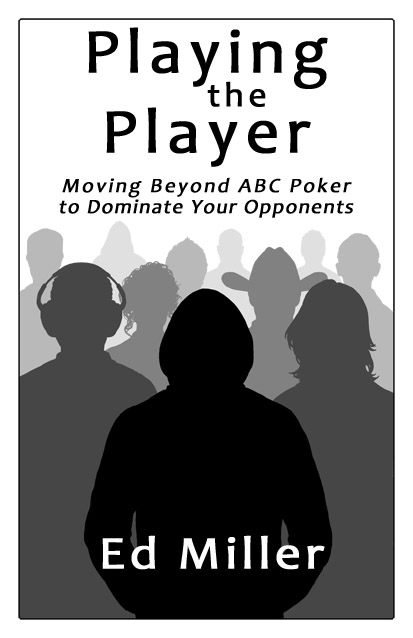If everyone who has ever asked me how to go about learning to play winning poker just read, and more importantly, mastered, everything Ed Miller has published they would already be fairly good poker players. I can’t think of a single author who has consistently put out so much useful information.
Miller’s latest contribution to the education of poker players is titled, “Playing the Player: Moving Beyond ABC Poker to Dominate Your Opponents.”
Similar to his last book, How to Read Hands, this book is for people who have learned the fundamentals of Hold’em and are looking to take their game to the next level. In other words, you already know all of the other standard lines on how to play a hand but you’re looking for something extra.
Playing the Player (along with How to Read Hands) is the next level. As Miller explains, most poker players learn how not to lose money. Very few books have been written specifically on how to increase your win rate. If you view poker as a game of risk management, most poker strategies are too risk averse.
That may sound odd at first but give it some thought. Most poker books and DVDs focus on eliminating the most common mistake in poker which is playing too many hands. That’s why starting hand charts are standard training tools. But the starting hand chart is really just a tool to steer you away from high-risk situations.
After that, the rest of the book will mostly be filled with low-risk plays like protecting a hand or raising to see a free card.
Unfortunately, this makes you a very predictable player. And if everyone else at the table has eliminated all of the most common poker mistakes, your edge over your opponents shrinks to almost nothing.
And this is where Playing the Player comes in. Miller’s focus is on exploiting the mistakes your opponents make. Whether they’re a TAG, LAG, or total fish, their playing style lends itself to mistakes which can be exploited.
This is where most other poker books fall down. The vast majority of poker literature either assumes your opponents play perfectly or categorize people into broad categories like eagles, lions, or three toed sloths. Miller’s book identifies the mistakes various types of players make and how you can maximize your win rate against those mistakes.
For instance, the chapter on Tight Players is broken down into mistakes tight players make and how to counter. Say you have an opponent who won’t get all his money into the pot without the stone cold nuts. If you were reading a book emphasizing playing ABC poker, they might not even mention an opponent like this other than to call them tight.
In Playing the Player, Miller explores strategies that can be employed specifically against people who exhibit this flaw in their game. Since we already know this person folds too easily, your strategy should include firing more barrels at these types of players regardless of the cards you’re holding.
To a certain degree this flies in the face of conventional poker wisdom. Most poker books will tell you that if a tight player raises you should fold all but your strongest hands. It’s not necessarily an incorrect choice as a tight player raising will likely have a strong hand but if you also know that this player can be pushed off any non-nut hand then it changes the value proposition of calling and seeing a flop since there are a lot more opportunities to win the hand outside of having the best hand at showdown.
While Miller does discuss specific strategies to use against various types of errors your opponents make, the real value in Playing the Player is in thinking about problems differently. Miller pushes you to step outside of your game and start thinking about things on a different level.
You’re not going read this book and start crushing Phil Ivey tomorrow but it’s an important next step for players who have been playing ABC poker and found themselves frustrated that their win rates have been going down.
The game is evolving and ABC poker simply isn’t as profitable as it once was. It’s not enough to  fit or fold poker anymore. We’ve all read the same books. We’re all using the same starting hand charts.
fit or fold poker anymore. We’ve all read the same books. We’re all using the same starting hand charts.
If you want to continue to excel at the game players need to get out of the ABC poker rut and start thinking. Memorized plays just aren’t going to cut it in today’s game. You need to be able to recognize errors that your opponents make and develop strategies that exploit those errors for maximum return.
In other words, instead of playing 24 tables of ABC poker and complaining you can barely grind out a profit, you need to focus on each game, each opponent, and be prepared to pounce on their weaknesses.
Playing the Player doesn’t change anything you learned in the classic books like The Theory of Poker but it does apply many of those ideas in ways that most players aren’t familiar with. Exploiting your opponent’s mistakes has always been a fundamental part of poker theory but most poker books assume your opponents all make the same types of mistakes.
As I read Playing the Player I often found myself thinking about playing heads-up. I used to play a lot of heads-up sit and gos back in the day and my strategy was very similar to what Miller recommends in Playing the Player.
Heads-up is a very dynamic game. You are constantly switching styles of play. If your opponent is playing too passive you pummel them with raises. When they figure out that you’re raising with any two cards and start to fight back, you switch styles. When they figure out that you’ve switched gears on them, you switch it up on them again.
Evolving and changing gears is a core element of Playing the Player. If your opponent is playing too loose, use a strategy that exploits mistakes loose players make. If they play too tight, use a strategy that exploits nitty mistakes. If they catch on to what you’re doing and adjust, re-adjust your game.
Unless you’re playing with the top players in the world, your opponents likely have gaping holes in their game. Games today only seems tougher because we’ve all been taught a strategy which is meant to exploit mistakes that your opponents have since learned not to make. Rather than adapting, most players just keep playing the same game and complain about how they can’t make any money.
If you’re still playing ABC poker you’re leaving money on the table. Poker has changed and so should your game. Buy Playing the Player.
